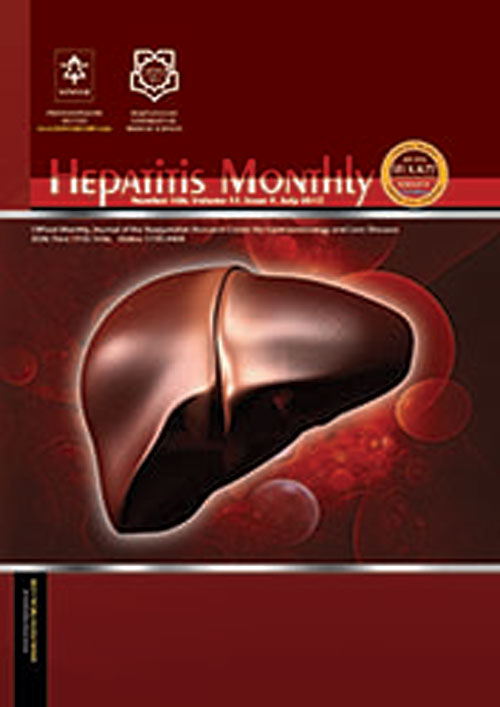فهرست مطالب

Hepatitis Monthly
Volume:18 Issue: 11, Nov 2018
- تاریخ انتشار: 1397/08/12
- تعداد عناوین: 3
-
-
Page 1BackgroundHepatitis A is a virus with linear and positive strand RNA. As HAV has no envelope, it is more resistant to environmental stress than other hepatitis viruses, and it can be transmitted by water and food. HAV infection is acquired commonly by the fecal-oral route and in adults, it can leave very serious complications, including fulminate hepatitis. The virus is infectious for one to two weeks in the bloodstream before symptoms appear. In the acute phase of the disease, when the virus is presented in the bloodstream, it is possible to transfer via blood transfusion and plasma products.ObjectivesThis study was designed to determine the frequency of antibodies against HAV and the acute phase of the disease among blood donors in Golestan province in the northeast of Iran.MethodsSera of 400 blood donors in Golestan province who were negative for anti-HIV, HBs Ag, and anti-HCV were tested for the total anti-HAV antibody, anti-HAV IgM, and HAV-RNA. Total antibodies (IgG+IgM) and IgM were determined by the ELISA method using commercial kits. HAV-RNA was detected by nested RT-PCR.ResultsOverall, 91% of the analyzed specimens were anti-HAV seropositive and all blood donors were negative for anti-HAV IgM. HAV-RNA was not found in any serum samples.ConclusionsThe prevalence of HAV was high among blood donors in Golestan province and due to high anti-HAV seroprevalence rates, the blood donors are safe in terms of virus transfer.Keywords: Hepatitis A Virus (HAV)_Volunteer Blood Donors_Golestan Province
-
Page 2BackgroundSince manicure and pedicure professionals are exposed to blood and to other human body fluids, these workers are susceptibile to hepatitis viruses (HBV, HCV) when they fail to follow standard safety procedures (SSP) in their work routine. Knowledge on SSP is one of the main factors to reduce contamination risks.ObjectivesThe current study investigated correlations between knowledge on SSP and the occurrence of HBV/HCV in manicure/pedicure professionals working at beauty salons in Maringá (Paraná-Brazil).MethodsA cross-sectional study was conducted between March 2015 and March 2016. Beauty salons (n = 30) were visited and 150 professionals completed a questionnaire and a rapid test for HBV/HCV detection.ResultsData indicated that there were no correlations (P < 0.01) between knowledge about transmission and prevention of viral hepatitis and professional behaviors of manicure/pedicure in beauty salons of Maringá. There was low adherence (P < 0.01) to SSP and to procedures that would guarantee an adequate sterilization of the materials used. One out of 150 individuals showed reactivity for HBV (genotype D by HBV DNA).ConclusionsManicure and pedicure professionals in Maringá were aware of the correct procedures to warrant personal protection, yet such knowledge is not adequately applied in their work routine.Keywords: Hepatitis B, Hepatitis C, Manicure, Pedicure Service, Biosafety
-
Page 3BackgroundErythropoietic protoporphyria (EPP) is a rare autosomal dominant disease that is caused by partial ferrochelatase (FECH) deficiency because of a genetic mutation in the FECH gene.ObjectivesThe aim of this study was to investigate the genetic mechanism of EPP in a Chinese family.MethodsClinical physical examination, laboratory testing, and medical history tracking were performed for phenotyping. The FECH gene was sequenced for genotyping.ResultsThe proband presented EPP with severe liver dysfunction. A novel nonsense mutation of c.910 C>T in the FECH gene, resulting in p.Arg304Ter, was identified in the proband as well as her symptomatic mother, aunt, and asymptomatic male cousin. The proband and her living family members, except the asymptomatic male cousin, carried the alleles IVS 3-48C and IVS 1-23T on the FECH gene. The mutation of c.910 C>T in the FECH gene presented its heterozygous autosomal dominant inherent clinical manifestations, only in the presence of the heterozygous alleles IVS 3-48C and IVS 1-23T. The frequencies of the alleles IVS 3-48C and IVS 1-23T were 30.8% and 27.9% in a northeast Chinese Han population, respectively.ConclusionsA new nonsense mutation of c.910 C>T was identified in the FECH gene, which expressed EPP with severe liver dysfunction when it was co-inherited with the heterozygous alleles IVS 3-48C and IVS 1-23T, in a Chinese family.Keywords: Nonsense Mutation, FECH, Erythropoietic Protoporphyria, Chinese

